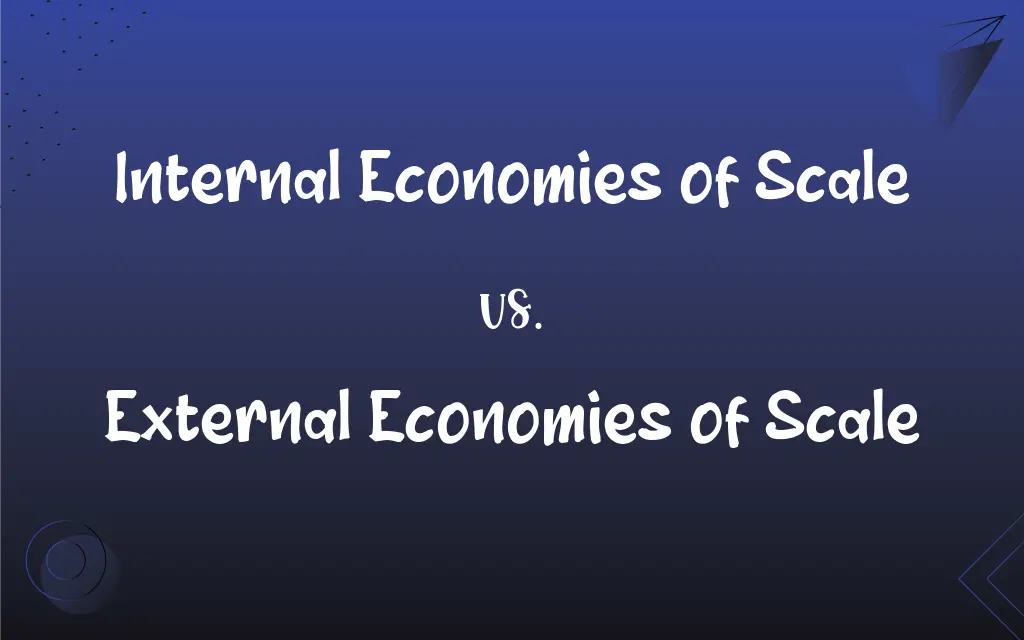Internal Economies of Scale vs. External Economies of Scale: What's the Difference?
Edited by Aimie Carlson || By Harlon Moss || Published on February 17, 2024
Internal economies of scale are cost savings within a company due to expansion, while external economies are savings due to industry growth or external factors.

Key Differences
Internal economies of scale occur when a company reduces costs through increased production, leading to efficiencies in areas like manufacturing, purchasing, or research and development. External economies of scale, however, arise not from the company's own growth, but from factors outside the firm, such as industry growth or regional economic developments.
A company experiences internal economies of scale through improved production processes, bulk purchasing, or enhanced bargaining power with suppliers. In contrast, external economies of scale might occur when an entire industry benefits from infrastructure improvements, technological advancements in the sector, or a skilled labor pool in a particular region.
Internal economies of scale are specific to a company and depend on its management strategies, production techniques, and scale of operation. External economies of scale, on the other hand, benefit all companies in an industry or region, regardless of their individual strategies or efficiencies.
A business achieving internal economies of scale might reduce its unit costs by automating production or centralizing operations. Alternatively, external economies of scale could result from a cluster of businesses in the same industry driving down costs for all through shared services or infrastructure.
Internal economies of scale are controllable by the company and can lead to a competitive advantage. External economies of scale are beyond a single company's control and tend to benefit all players in a market or location equally.
ADVERTISEMENT
Comparison Chart
Source of Cost Savings
From within the company's operations and growth.
From industry growth or external factors in the environment.
Control
Under the company's control and influenced by its decisions.
Beyond a company's control, affected by industry or region.
Specificity
Specific to individual companies.
Benefits all firms in an industry or region.
Examples
Enhanced production efficiency, bulk purchasing.
Infrastructure improvements, technological advancements.
Impact on Competitive Advantage
Can provide a unique competitive advantage.
Offers a general advantage to all industry players.
ADVERTISEMENT
Internal Economies of Scale and External Economies of Scale Definitions
Internal Economies of Scale
The decrease in cost per unit resulting from increased production, specific to a company.
Internal economies of scale allowed them to reduce prices and stay competitive.
External Economies of Scale
Savings derived from a conducive business environment or industry-specific advancements.
The training programs in the region resulted in external economies of scale in skilled labor availability.
Internal Economies of Scale
Reduction in costs due to internal factors like better resource utilization.
Their internal economies of scale were evident in their reduced logistics costs.
External Economies of Scale
Cost savings that accrue to all firms in an industry due to external factors.
The industry experienced external economies of scale due to regional infrastructure development.
Internal Economies of Scale
Cost benefits a company gains by expanding operations or output.
Expanding their factory operations led to significant internal economies of scale.
External Economies of Scale
Cost advantages resulting from factors outside a single company's control.
The creation of a local supplier network created external economies of scale for the industry.
Internal Economies of Scale
Savings from improved efficiency within a company due to scale.
The firm's internal economies of scale came from streamlining its manufacturing process.
External Economies of Scale
Reductions in unit costs for all firms in a sector, not just one company.
External economies of scale occurred when the local government improved transport links.
Internal Economies of Scale
Cost reductions achieved by a company as it increases production.
By doubling its output, the company achieved internal economies of scale, lowering its unit cost.
External Economies of Scale
Benefits gained by firms from the overall growth and development of their industry.
Technological advancements in the sector led to external economies of scale for all manufacturers.
FAQs
Are external economies of scale industry-specific?
Generally, yes. They often relate to advancements or developments specific to a particular industry.
Can a small company achieve internal economies of scale?
Yes, through efficient scaling and process improvements, even small companies can achieve internal economies.
Do internal economies of scale always lead to lower prices?
Not necessarily, but they can give a firm the option to reduce prices due to lower costs.
How do external economies of scale differ?
They arise from industry growth or regional developments, benefiting all companies in the area or sector.
Is bulk purchasing an internal or external economy?
It's an internal economy, as it's a cost-saving measure a company can control.
What are internal economies of scale?
Cost reductions within a company due to increased production and operational efficiencies.
Can external economies of scale lead to unfair advantages?
They offer benefits to all firms in the area or industry, so they don't typically confer an unfair advantage.
What triggers external economies of scale?
Factors like regional infrastructure improvements or technological advances in an industry.
Can internal economies of scale lead to monopolies?
In some cases, if they lead to significant cost advantages that competitors can't match.
How do technological innovations relate to external economies?
Innovations can drive industry-wide efficiencies, benefiting all companies within that industry.
What's an example of internal economies of scale?
A firm reducing costs by automating its production line is an example.
Do external economies of scale require government intervention?
They can be influenced by government policies but don't always require direct intervention.
Are external economies of scale more beneficial for startups?
They can be, especially if the startup is in a supportive industry cluster or region.
How do internal economies impact competition?
They can give a company a competitive edge by allowing for cost leadership or price reductions.
How do companies plan for internal economies of scale?
Through strategic planning in scaling operations, technology adoption, and process optimization.
Can external economies of scale be controlled by a single firm?
No, they're beyond the control of any one firm and depend on wider industry or regional factors.
Does globalization affect internal economies of scale?
It can, by opening up new markets and opportunities for scaling.
Can environmental regulations impact external economies?
Yes, they can create new industry standards that benefit all firms compliant with them.
Do internal economies of scale reduce operational risks?
They can, by creating more efficient and robust operational processes.
Can a decline in an industry affect external economies of scale?
Yes, a downturn in an industry can reduce or eliminate these economies.
About Author
Written by
Harlon MossHarlon is a seasoned quality moderator and accomplished content writer for Difference Wiki. An alumnus of the prestigious University of California, he earned his degree in Computer Science. Leveraging his academic background, Harlon brings a meticulous and informed perspective to his work, ensuring content accuracy and excellence.
Edited by
Aimie CarlsonAimie Carlson, holding a master's degree in English literature, is a fervent English language enthusiast. She lends her writing talents to Difference Wiki, a prominent website that specializes in comparisons, offering readers insightful analyses that both captivate and inform.































































